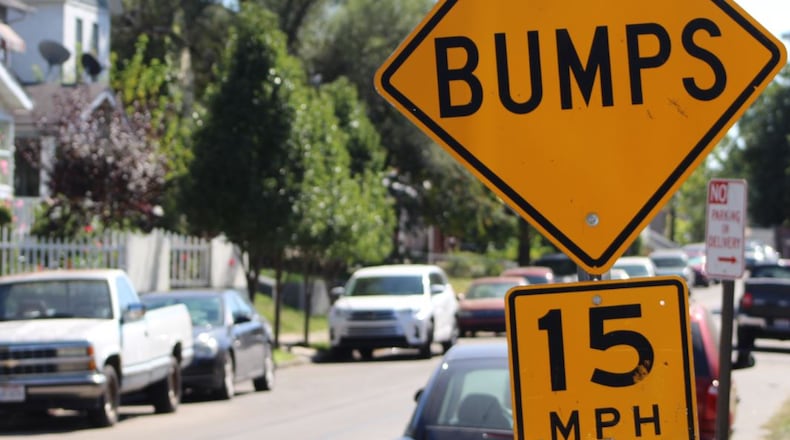But other residents aren’t convinced they make a big difference, and Dayton Mayor Nan Whaley says there are more effective ways to calm traffic that the city hopefully will use in the future to make streets safer for motorists and pedestrians.
“I think we can engineer much better options over time,” she said.
RELATED: Dayton’s traffic cameras will run 24/7 without police present
Dayton’s speed humps and bumps have primarily been installed at the request of residents and have proven effective at reducing traffic speeds, a city spokesperson said.
In order to get a speed hump or bump installed, more than half of affected residents in a neighborhood have to sign a petition in the support of the addition, officials said.
Speed humps are 12 feet wide and speed bumps are 2 feet wide. The city has replaced or installed 24 speed bumps this year, at a cost of about $47,300, city data show. The city this year added new humps on Valerie Arm Drive in northwest Dayton.
RELATED: Traffic deaths spiked in 2016, including pedestrians killed
Maryland Avenue in Old North Dayton contains seven speed bumps, as well as a series of stop signs.
Some residents say the bumps are the only thing preventing people from racing down the street at reckless speeds.
“I think they work very well,” said Deborah Schell, a long-time resident of the block. “I actually think they should be higher.”
Most homes on Maryland Avenue are occupied by families with children, and the humps stop drivers from being able to travel at excessively fast speeds, she said.
FULL COVERAGE: Helping you understand Ohio Issue 2
“If there’s not a lot of kids in a neighborhood, why have them?” she said. “But the speed bumps are to keep the kids safe … I’ve seen several of them almost get hit if it wasn’t for the speed bump.”
Judy Hill, 71, who lives at Maryland Avenue and Keifer Street, said her neighborhood does not have a lot of speeding vehicles and traffic is a minor issue.
Hill said the speed humps have been there for years and are leftover from when Webster Elementary School was still open. The school has been torn down. She’s not sure if they really slow traffic.
“They were necessary because the school was there, but now that we don’t have the school, I don’t know if we need them or not,” she said.
MORE: 4 restaurants, retailers coming to vacant Logan’s Roadhouse
Mayor Whaley says studies indicate that protected bike lanes, pedestrian improvements and “road diets” are more effective traffic-calming measures than speed bumps and humps.
Road diets reconfigure streets reduce their width or number of lanes.
Motorists often speed up after passing over speed bumps and humps, moving at dangerous speeds, and they also can cause additional wear and tear on citizens’ vehicles, Whaley said.
“I have them in my neighborhood, and they calm traffic in the sense that I go around them when I drive,” she said. “I don’t go on streets that have them.”
The city of Dayton has adopted a long-term transportation plan to help guide decisions and investments about how to reconfigure and re-imagine the city’s streets.
The city wants a “complete streets” approach to transportation and infrastructure projects that incorporate pedestrian and bicycle facilities, traffic calming features, streetscapes and green components.
To create more of a pedestrian environment on residential streets, the city could add highly visible crosswalks or raised or paved crosswalks and more signage, according to the 2040 transportation plan.
Other traffic calming measures like “curb bulb outs” that extend the curb into the roadway, the plan states.
About the Author

